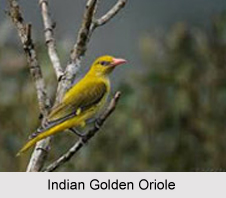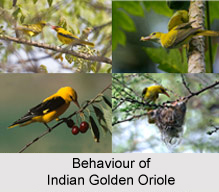 Indian Golden Oriole is an Indian bird that bears a scientific name "Oriolus kundoo". It is a species of oriole found in the Indian states and Central Asia. The species was once considered to be a subspecies of the Eurasian Golden Oriole, but has been elevated to a full species on the basis of differences in morphology, plumage, calls and the fact that the two do not intergrade.
Indian Golden Oriole is an Indian bird that bears a scientific name "Oriolus kundoo". It is a species of oriole found in the Indian states and Central Asia. The species was once considered to be a subspecies of the Eurasian Golden Oriole, but has been elevated to a full species on the basis of differences in morphology, plumage, calls and the fact that the two do not intergrade.
Adults Indian Golden Oriole
The adult Indian Golden Oriole can be told apart from the Eurasian Golden Oriole by the black of the eye stripe extending behind the eye.
Breeding of Indian Golden Oriole
Indian Golden Oriole is a partial migrant. It breeds in Pakistan, Uzbekistan, Turkmenistan, Kazakhstan, Kyrgyzstan, Tajikistan, Afghanistan and Nepal, as well as much of India. The Indian populations are largely resident while other populations are migratory.
Structure of Indian Golden Oriole
Indian Golden Oriole is very similar to the Eurasian Golden Oriole but has more yellow in the tail and has a paler shade of red in the iris and bill. The male has the black eye stripe extending behind the eye, a large carpal patch on the wing and wide yellow tips to the secondaries and tertiaries.
Streaks of Indian Golden Oriole
The streaks on the underside of females are sharper than in the females of the Eurasian Golden Oriole. The European species is larger with a wing length of 149-162 in adult males compared to 136-144 in O. kundoo.
Wings of Indian Golden Oriole
The wing formula of Indian Golden Oriole is also different with primary 2 longer than 5 in O. oriolus while primary 5 is longer than 2 in O. kundoo. A population named baltistanicus was considered by Charles Vaurie to be indistinguishable from kundoo while turkestanica appeared to be based on a specimen of a typical Oriolus oriolus
 Nests of Indian Golden Oriole
Nests of Indian Golden Oriole
Indian Golden Oriole breeds from Baluchistan and Afghanistan along the Himalayan Mountain Range to Nepal. Some populations breed in the peninsular region but are very local. The northern populations winter in southern India, with some birds wintering in Sri Lanka.
Habitat of Indian Golden Oriole
Indian Golden Oriole inhabits a range of habitats including open deciduous forests, semi-evergreen forests, woodland, forest edge, mangroves, open country with scattered trees, parks, gardens orchards and plantations.
Feeding of Indian Golden Oriole
Indian Golden Oriole feed on fruits, nectar and insects. They are capable of dispersing the seeds of many berry-bearing plants including the invasive Lantana camara. An oriole has been recorded preying on Draco dussumieri.
Flights of Indian Golden Oriole
The flight of Indian Golden Oriole is dipping but strong and has been recorded to reach about 40 km/h. They sometimes bathe by repeatedly flying into a small pool of water. An individual ringed in Gujarat was recovered in Tajikistan more than nine years later.
Favourable Seasons of Indian Golden Oriole
The breeding season of Indian Golden Oriole is from April to August, the nest being a small cup placed in a fork near the end of a branch. Nests are often built in the vicinity of the nest of a black drongo. Two or three white eggs with reddish, brown and black speckling form the typical clutch. Both parents take part in nest and brood care, defending the nest against intruding birds such as Shikras and Crows.











